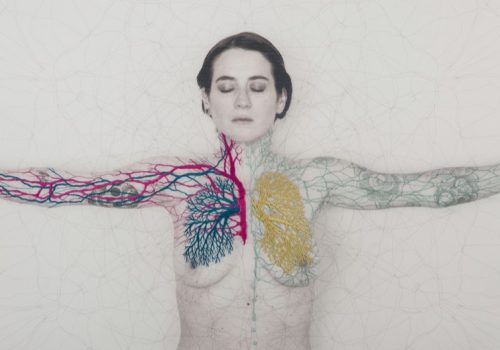Chilean artist Juana Gómez’s hand embroidered photographic canvases combine the spheres of scientific exploration with ancestral tradition. Weaving complex scientific and mythological patterns onto images of both her own and her daughters’ bodies, her work is interested in placing mankind within a broader context of interconnectivity. Rather than seeing us as individuals, dethatched from one another and the world around us, Gómez positions us as part of an ancient chain that goes back to the origin of life: a combination of patterns, molecules and small organisms.
The word Distaff, the title of her exhibition currently on view at Michael Hoppen Gallery in London, defines both the matrilineal branch of a family, and also the “domestic life,” describing a tool that bears the same name used for manually spinning fleece. Both meanings are relevant to Gómez’s work, as she utilizes weaving and embroidery to explore the themes of genealogy, mythology and biology within her own female lineage. An art form customarily inherited through the matriarchal line, spinning or weaving, was traditionally passed from mother to daughter.
Images of Gómez and her daughter Julieta populate the exhibition, along with the hands of four generations of their female line. The embroidery encompassing their bodies creates a link between them that is both physical and symbolic, telling of blood ties and the passing of time.
One of the central pieces in the exhibition The Pattern of Origin depicts the faces of both mother and daughter in perfect symmetry, generating the illusion of a mirror in which we could be looking at the same person but at different ages. Embroidered over the figure of Julieta is a representation of the lymphatic system, the main function of which is to maintain our immune system’s balance; acting as a defense shield against the unfamiliar or dangerous, much like a mother to a young child.
Folklore and myth have an evident influence in the artist’s iconography, as exemplified in the tattooed crow on her hand, highlighted in black thread on one of the works in the exhibition. Crows are representative in certain cultures of ancestral memories, are linked to death, and were also known to possess the gift of vision. According to some myths the crow flew out of the cosmos’ dark womb to bring sunlight (or knowledge) to Humankind. This solar creature embodies the bridge between light and darkness, between ancient wisdom and the transformative new.
Elsewhere, Julieta and Juana are embroidered with extraordinary labyrinths of nervous systems, silver threaded organs, bacteria, and the symbols found on traditional Latin American textiles. United in tissues and cells, by their heritage, by the air they breathe and the blood that passes just a few millimeters below the skin; Gómez highlights the unseen elements that link generations, families, civilizations; and also humans, and animals with the earth.
Carolina Castro
Carolina Castro is an author specizalizing in arts. She lives and works in London, UK.
Juana Gómez, Distaff
November 1 to December 22, 2017
Michael Hoppen Gallery
3 Jubilee Pl, Chelsea
London SW3 3TD
United Kingdom
















